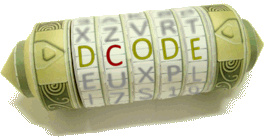Tool to learn card names. A classic playing card deck has 52 cards, 4 colours: Spades, Hearts, Diamonds and Clubs. Faces (king, queen, jack) have a name.
Playing Cards - dCode
Tag(s) : Raw Data, Board Games
dCode is free and its tools are a valuable help in games, maths, geocaching, puzzles and problems to solve every day!
A suggestion ? a feedback ? a bug ? an idea ? Write to dCode!
Playing Cards
Playing Cards
English Deck
Spades (or pikes):












1♠,2♠,3♠,4♠,5♠,6♠,7♠,8♠,9♠,10♠,J♠,Q♠,K♠
Hearts:












1♥,2♥,3♥,4♥,5♥,6♥,7♥,8♥,9♥,10♥,J♥,Q♥,K♥
Clubs (or clovers):












1♣,2♣,3♣,4♣,5♣,6♣,7♣,8♣,9♣,10♣,J♣,Q♣,K♣
Diamonds (or tiles):












1♦,2♦,3♦,4♦,5♦,6♦,7♦,8♦,9♦,10♦,J♦,Q♦,K♦
Random Card Draws
Answers to Questions (FAQ)
What are the distinct cards of a classic card deck? (Definition)
A deck of cards is made up of 13 distinct values: Ace (A or 1), 2, 3, 4, 5, 6, 7, 8 ,9, 10 (or T), Jack (J), Queen (Q), King (K).
The values are reproduced on 4 different colors: Spades (black), Diamonds (red), Clubs (black) and Hearts (red), (yes, there are actually only 2 true colors: red or black)
52 cards in total (used in most games, like poker)
The deck of playing cards is often completed with 2 jokers (one red, one black)
Cards that do not have a number (J, Q, K) are sometimes referred to as face cards or court cards.
Why these card names?
The four kings names and the jack of diamond (Hector) are among the Nine Worthies (9 heroes Pagan, Christian and Jewish, respected for their glory of war in Europe). There are also 2 queens (Judith and Rachel) that are part of the Nine Worthies Women.
Cards between 2 and 10 do not have a name.
Which are honourable cards?
The strongest cards are called honors in some games (eg. Bridge), the 10, the jack, the queen, the king and the ace.
What is the name of other cards?
It is possible to give a two letters name for cards depending on its value and color.
Example: Ace of Spades = 1S or AS
Example: Two of Clubs = TC or 2C
Example: Five of Diamonds = FD or 5D
Sometimes, names are not unique: TH = 2 of Hearts or 3 of Hearts.
What is the order of cards in a brand new deck?
The order varies slightly depending on the card manufacturer. But, the biggest manufacturers of card games generally use the same order: Spades from Ace to King, then Diamonds, then Clubs then Hearts. 2 joker cards are often added, either at the beginning or at the end.
What is the order of suits?
In bridge, the order is clubs < diamonds < hearts < spades
In many other games, suits are all the same strength.
Why these colors (suits)?
The suits (spades, hearts, diamonds, clover) appear to be from an adaptation of the Germanic signs representing acorns, bells, leaves and hearts. For the origin of these 4 other symbols, no explanation is unanimous.
What is the role of jokers?
The use of the joker varies between games, but sometimes it is simply used to replace a damaged or lost card.
Example: In Canasta the joker has a trump role.
In several known game variants, jokers can be used like in Freecell or Klondike solitaire (the black joker can represent any black card, and the same for the red joker)
What it the acorn or the bell?
In Germany or Switzerland, the acorn and the bell replace the clubs and diamonds respectively.
What are Unicode codes for spade, heart, diamond and clover?
The codes of the Unicode characters corresponding to Spades, Hearts, Diamonds and Clovers are:
| ♠ | 2660 | ♡ | 2661 | ♢ | 2662 | ♣ | 2663 |
| ♤ | 2664 | ♥ | 2665 | ♦ | 2666 | ♧ | 2667 |
Source code
dCode retains ownership of the "Playing Cards" source code. Any algorithm for the "Playing Cards" algorithm, applet or snippet or script (converter, solver, encryption / decryption, encoding / decoding, ciphering / deciphering, breaker, translator), or any "Playing Cards" functions (calculate, convert, solve, decrypt / encrypt, decipher / cipher, decode / encode, translate) written in any informatic language (Python, Java, PHP, C#, Javascript, Matlab, etc.) or any database download or API access for "Playing Cards" or any other element are not public (except explicit open source licence). Same with the download for offline use on PC, mobile, tablet, iPhone or Android app.
Reminder: dCode is an educational and teaching resource, accessible online for free and for everyone.
Cite dCode
The content of the page "Playing Cards" and its results may be freely copied and reused, including for commercial purposes, provided that dCode.fr is cited as the source (Creative Commons CC-BY free distribution license).
Exporting the results is free and can be done simply by clicking on the export icons ⤓ (.csv or .txt format) or ⧉ (copy and paste).
To cite dCode.fr on another website, use the link:
In a scientific article or book, the recommended bibliographic citation is: Playing Cards on dCode.fr [online website], retrieved on 2026-01-01,
- Playing Cards
- Random Card Draws
- What are the distinct cards of a classic card deck? (Definition)
- Why these card names?
- Which are honourable cards?
- What is the name of other cards?
- What is the order of cards in a brand new deck?
- What is the order of suits?
- Why these colors (suits)?
- What is the role of jokers?
- What it the acorn or the bell?
- What are Unicode codes for spade, heart, diamond and clover?
